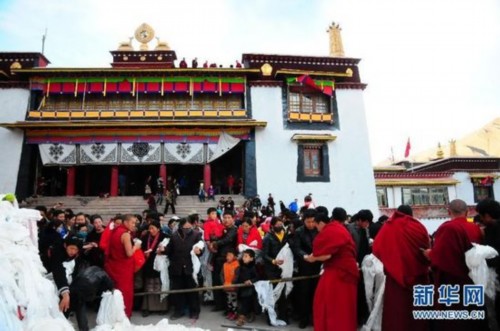

 |
| file photo |
Govt to continue to offer insurance subsidies to clergy
The Party chief of Southwest China's Tibet Autonomous Region reiterated Wednesday that China's national flag should be flown on all local temples, which analysts see as a part of efforts to maintain social stability in Tibet.
The People's Daily published an article written by Tibetan Party chief Chen Quanguo on Wednesday, who re-emphasized that all temples will have the national flag, communication services, newspapers, book stores, water and electrical supply and television broadcasts.
The local government should continue improving the temples' public services and facilities in Tibet. The region will also offer pension and medical insurance policies to registered monks and nuns at all monasteries and free health check-ups "to make them experience the care and warmth of the Party and government," wrote Chen.
Chen added that the regional government will launch a legal education campaign at temples.
"Almost all the temples in Tibet have been flying the national flag, and the national leaders' portraits are visible in the clergies' rooms," Bujum, director of the monastery management committee in Jokhang Monastery in Lhasa, told the Global Times, adding that temples in rural areas have been also provided with public services like radio and television.
Analysts pointed out that it is part of the nation's efforts to maintain social stability by flying national flags and improving clergies' livelihood, as the sense of sovereignty, represented by national flags, can be strengthened to combat separatism.
According to a local guideline in 2011, temples should be equipped with nine items, including four national leaders' portraits, national flags, newspapers and televisions to promote the "sense of responsibility to national unity and social stability" among monks and nuns. All funds would be provided by the region's finance department, reported the news portal chinatibetnews.com.
In 2012, a total of 1,879 monks and nuns in Tibet over 60 years old began receiving a basic pension fund of 120 yuan ($19.3) per month without having to pay for premiums from this year. Others can choose to pay from 100 yuan to 3,000 yuan per year for at least 15 years. After they turn 60, they can get basic pensions ranging from 134 to 452 yuan a month.
Meanwhile, a monk can pay 60 yuan a year for his medical insurance and be subsidized 220 yuan by the government.
Monks and nuns used to rely on financial support from their families or disciples and alms from worshippers, according to Bujum.
"The clause about the subsidy bonus is an important stimulus for monasteries and their clergy to abide by law and maintain social stability," Lhapa, a monk at Jokhang Temple, told the Xinhua News Agency.
 J-11 fighters in air exercise
J-11 fighters in air exercise Beauties dancing on the rings
Beauties dancing on the rings Attendants-to-be join Mr. & Miss Campus Contest
Attendants-to-be join Mr. & Miss Campus Contest Beijing's toughest anti-smoking law takes effect
Beijing's toughest anti-smoking law takes effect Family lives in cave for about 50 years in SW China
Family lives in cave for about 50 years in SW China PLA soldiers operating vehicle-mounted guns in drill
PLA soldiers operating vehicle-mounted guns in drill Blind carpenter in E China's Jiangxi
Blind carpenter in E China's Jiangxi China hosts overseas disaster relief exercise for the first time
China hosts overseas disaster relief exercise for the first time 20 pairs of twins who will become flight attendants in Sichuan
20 pairs of twins who will become flight attendants in Sichuan Obama is sowing discontent in S.China Sea
Obama is sowing discontent in S.China Sea Rescuers work through night to reach cruise ship survivors
Rescuers work through night to reach cruise ship survivors Driving through limbo
Driving through limbo Facing down MERS
Facing down MERSDay|Week